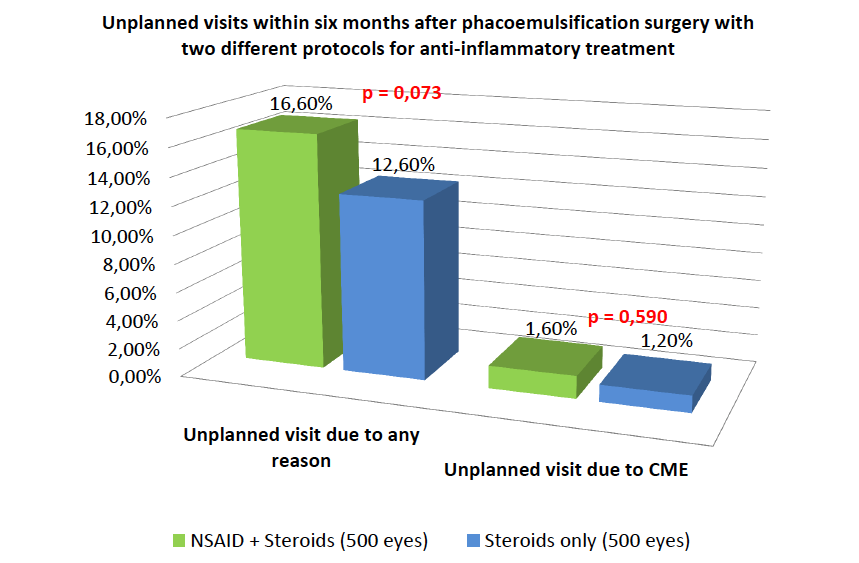Article
Large population-based study questions value of routine NSAID use after cataract surgery
Author(s):

Neither the need for unplanned postoperative visits for complications nor the incidence of visually disturbing cystoid macular edema (CME) was significantly reduced by adding a topical NSAID to postoperative topical steroid treatment, finds a recent study.
A retrospective population-based controlled study analyzing data from an unselected patient population undergoing phacoemulsification surgery found that neither the need for unplanned postoperative visits for complications nor the incidence of visually disturbing cystoid macular edema (CME) was significantly reduced by adding a topical NSAID to postoperative topical steroid treatment.
The research, however, did highlight increased susceptibility to postoperative CME in eyes with preexisting vitreoretinal conditions.
“Results of randomized controlled trials indicate that the occurrence of CME is reduced in eyes treated with an NSAID, either in combination with a steroid or alone,” said Jan Gärdin, MD, resident, Department of Ophthalmology, Linköping University, Linköping, Sweden.
However, it is sometimes difficult to relate study results to what is perceived as clinical reality. In our investigator-initiated study including a large number of eyes from an unselected patient population, we were not able to demonstrate a clear benefit for the cohort that received combination therapy, Dr. Gärdin added.
RELATED: Intracamerally injected mydriatic agents in cataract surgery: Good safety profile
“Although randomized controlled studies remain the gold standard for evaluating the efficacy of new treatments, adequately designed and conducted clinical studies such as our retrospective population-based trial are an important complement to clarify how medical and surgical treatments are used in an optimal fashion in unselected clinical populations," said Björn Johansson, MD, PhD, coinvestigator in the study and associate professor of ophthalmology, Linköping University. "The findings from such studies may have both medical and economic impact.”
The population-based controlled study analyzed data from two groups of consecutive patients operated on in the eye clinics of Vrinnevi Hospital, Norrköping, Sweden and Linköping University Hospital, Linköping, Sweden.
The two facilities are in the same county, publicly financed, and under the same regional clinical center, and they use the same electronic patient record system. However, they use different standard protocols for controlling postoperative inflammation, Dr. Gärdin explained.
RELATED: Novel delivery system shows positive performance in phase II trial
At Vrinnevi Hospital, patients are treated for 3 weeks after surgery with a topical steroid and a topical NSAID, each given 3 times daily. Patients undergoing cataract surgery at the eye clinic of Linköping University Hospital are treated only with a tapering dose of a steroid for 3 weeks.
Using the electronic medical record system and beginning the search in January 2015, the investigators identified a total of 500 consecutive eyes from each hospital. The selected eyes were from patients aged 20 years and older.
Patients were excluded if they had posterior capsular rupture and/or zonular damage preventing in-the-bag IOL placement, deviation from the center’s standard protocol for topical anti-inflammatory treatment, or a pre-existing ocular malformation. Data were extracted on baseline characteristics and unplanned postoperative visits within 6 months after surgery.
The two study groups were balanced with respect to gender and right/left eye distribution. Each group had a predominance of females over males and included a majority of right eyes. Mean age was about 75 years and similar in the two study groups.
Mean logMAR BCDVA was also similar in the two groups preoperatively.
RELATED: Managing ophthalmic surgery patients on antithrombotic drugs
A review of preoperative ocular comorbidities showed the percentage of eyes with pseudoexfoliation was higher in the group that received the steroid alone compared with those treated with combination therapy. The group receiving combination therapy had higher percentages of eyes with an epiretinal membrane (ERM) and with diabetic maculopathy or retinopathy. The number of patients with diabetes and with age-related macular degeneration was similar in the two groups.
Although a higher rate of unplanned postoperative visits was found for the group receiving combination treatment than among eyes treated only with a steroid, the difference was not statistically significant (16.6% versus 12.6%; p = 0.073). CME occurred in eight eyes (1.6%) in the combination treatment group and in six eyes (1.2%) treated with the steroid alone.
“The overall incidence of CME in our total cohort was 1.4%, but when patients with diabetes or an ERM were removed, the overall incidence of CME decreased to 0.8%,” Dr. Gärdin noted.
Clinically significant CME occurred in 2.9% of eyes in patients with diabetes mellitus and in 8.2% of eyes with an ERM.
“The incidence of clinically significant CME among patients in our study who had an ERM was 10-fold higher than in our patients without diabetes and no ERM, indicating patients with an ERM had a drastically increased risk,” Dr. Gärdin said.
RELATED: Prevention of CME, infection in lens-based surgery: Evidence-based approaches
Disclosures:
Jan Gärdin, MD
E: jan.gardin@regionostergotland.se
Dr. Gärdin has no relevant financial interests to disclose.
Björn Johansson, MD, PhD
E: bjorn.johansson@regionostergotland.se
Dr. Johansson is a consultant to companies that market topical anti-inflammatory medications.
This article is based on a paper presented at the 2019 meeting of the American Society of Cataract and Refractive Surgery.
Newsletter
Don’t miss out—get Ophthalmology Times updates on the latest clinical advancements and expert interviews, straight to your inbox.





